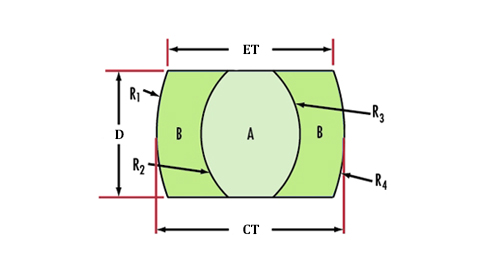ISO9001 Certified Professional Manufacturer & Supplier of Optics
+86-0431-87911611 admin@ytoptics.com
Contact us
-
 Email: admin@ytoptics.com
Email: admin@ytoptics.com
-
 Tel:86-0431-87911611
Tel:86-0431-87911611
-
 Add: 2# Automotive Innovation
Add: 2# Automotive Innovation
Jilin Province, China
Home > Products > Lenses > Triplet Lenses

N-BASF64 / N-BK7 / N-BASF64 Triplet Lenses
N-BK7(H-K9L) nd:1.516800 vd:64.20 ρ(g/cm³):2.52 N-BASF64(H-ZBaF20) nd:1.701540 vd:41.15 ρ(g/cm³):3.64
Share this:
| Relative Partial Dispersions | |||||||
| N-BK7(H-K9L) | N-BASF64(H-ZBaF20) | ||||||
| Ps,t | 0.3071 | P's,t | 0.3049 | Ps,t | 0.2390 | P's,t | 0.2360 |
|
PC,s |
0.5588 |
P'C',s |
0.6038 |
PC,s |
0.4971 |
P'C',s |
0.5367 |
| Pd,C | 0.3073 | P'd,C' | 0.2562 |
Pd,C |
0.2957 |
P'd,C' |
0.2460 |
| Pe,d | 0.2386 |
P'e,d |
0.2370 |
Pe,d |
0.2372 |
P'e,d |
0.2342 |
| Pg,F | 0.5359 |
P'g,F' |
0.4761 |
Pg,F |
0.5760 |
P'g,F' |
0.5102 |
| Pi,h | 0.7499 |
P'i,h |
0.7447 |
Pi,h |
0.8923 |
P'i,h |
0.8810 |
| Abnormal Dispersions | |||||||
| N-BK7(H-K9L) | N-BASF64(H-ZBaF20) | ||||||
| △PC,t | 0.0171 | △PC,s | 0.0052 | △PC,t | -0.0040 | △PC,s | -0.0019 |
| △PF,e | -0.0006 | △Pg,F | -0.0005 | △PF,e | 0.0000 | △Pg,F | 0.0004 |
What are the advantages and disadvantages of triplet achromatic lenses?
Advantages:
Effective correction of chromatic aberration: through the combination of different material lenses, chromatic aberration can be significantly reduced to improve imaging clarity.
Aberration correction: spherical and coma correction, the three-element design enables better correction of spherical and coma aberrations, improving image quality.
Design flexibility: optimized design, three lenses provide more freedom to optimize optical performance for different needs.
Relative simplicity: simple structure, compared to more complex systems, the three-piece design is easier to manufacture and assemble.
Disadvantages:
Higher cost: the use of special materials and precision processing increases costs.
Weight and bulk: compared to single or dual lenses, the three-piece design is heavier and larger and may not be suitable for portable devices.
Assembly complexity: precise alignment and adjustment is required during assembly, making it more difficult to manufacture.
Light loss: more lens surfaces may result in light loss and require coating to minimize reflections.
Highly Recommended Optical Lenses from Yutai Optics:
IR Lenses
Double Convex(DCX) Lenses
UV Fused Silica Cylindrical Lens
N-BAF10 / N-SF10 Achromatic Lenses

TALK TO US 86-0431-87911611
86-0431-87911611
Call us now!
 86-0431-87911611
86-0431-87911611Call us now!
ONLINE CHAT
 2433808388
2433808388

